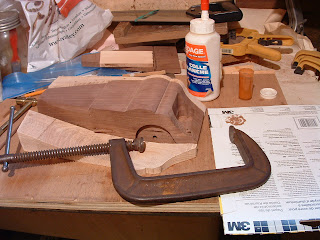This was the week to build the flat rad's flat radiator. Saturday I visited Stu to get a good look at his '53 flat rad 4 seater. It turns out the sides of the bonnet are off from the vertical by 5 degrees.
This is enough of a slope to make the sides of the front parallel. Some quick work with the plane and that was done.
I scaled down a picture I took perpendicular to the radiator to match the new width of the front. Then I traced it on some graph paper.
This left one last bit of bonnet shaping. I transferred the radiator outline to the sloped front of the body and using the thumb plane, wood file and 80 grit sand paper got the bonnet flowing smoothly from rad to scuttle.
Next we need to find out how wide the bars and the gaps are in the radiator, back to algebra class. The model radiator's grill width is 1 1/4". There are 15 slots and 14 bars in the grill. The bars on Stu's grill are 3/8" and the spaces 5/8". Therefore the ratio of bar width to slot width is 3:5.
We have two equations with two unknowns;
where:
s = slot width
b = bar width
1) 15s + 14b = 1.25
2) b/s = 3/5 = 0.6
Solve for s
2) -> b = 0.6s
Substitute in 1)
15s + 14 * 0.6s = 1.25
Therefore:
s = 0.053418803...
And:
b = 0.032051282...
So bars will be about 0.032" wide and the spaces between them about 0.053" wide. To avoid accumulating rounding errors by measuring between each bar and gap I built a spread sheet to add up the many decimal place numbers to get the total distance to each line from the outside edge of the rad (which adds 3/16" for the side). I rounded those numbers down to the nearest thou and measured them on the wood with vernier calipers.
I picked up a magnetic saw guide from Lee Valley with a Japanese style Dove Tail Saw to cut the gaps. Two cuts were needed for each gap since the saw kerf is only 0.031" while the gaps are to be 0.053".
Four or five hours of sawing later (Hop Hornbeam is very hard and on the second cut the saw would easily slip into the first cut so light pressure was needed.) I got my grill. The gaps look a little narrow but with some sanding to round over the front edges and black paint between the bars it should look OK.
Blackened:
Then over to the band saw to cut the rad out of the block of wood. And set the band saw at a 15 degree tilt to taper the sides and top to match the taper of the bonnet. That would have saved a lot of filing time but since I forgot to lock the tilt I'll have to start all over again from the beginning. It cut in too close to the first gap. There is no room for the rounded leading edge.
Hmm...
- the bars are a little uneven.
- the saw kerf, 0.031", is only a thou off the width for the bars.
- in squaring the the stock I got a long tapered piece of the Hop Hornbeam that is thnner than that at one end so it is possible to cut radiator bars on the table saw.
- so if I use the dove tail saw to make slots in the top and bottom tanks and slip thin strips in as the grill bars...
Watch this space.


















































